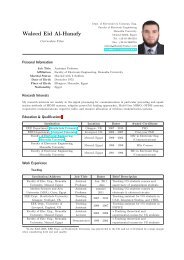Lecture 5
Lecture 5
Lecture 5
- No tags were found...
Create successful ePaper yourself
Turn your PDF publications into a flip-book with our unique Google optimized e-Paper software.
MIMO Channel Equalisation MATLAB Programming Conclusions<br />
System Model<br />
v<br />
s<br />
y ˜s<br />
H W H<br />
y = Hs+v (1)<br />
y — noisy N r-dimensional received vector<br />
s — N t-dimensional transmit vector ∈ S N is assumed to be a<br />
spatially-uncorrelated and uniformly distributed complex random vector process<br />
with zero-mean and variance σ 2 s (i.e. R ss = E [ ss H] = σ 2 sI Nt<br />
v — noise vector with dimension N r ×1 drawn from CN ( 0,σ 2 v)<br />
, or<br />
equivalently R vv = E [ vv H] = σ 2 vI Nr<br />
H — N r ×N t flat-fading channel with entries h ij are assumed i.i.d. complex<br />
Gaussian random variables with zero-mean and unit-variance E [ |h ij| 2] = 1, i.e.,<br />
h ij ∈ CN (0,1)<br />
Dr. Waleed Al-Hanafy Digital Signal Processing (ECE407) — <strong>Lecture</strong> no. 5<br />
Linear Equalisation of MIMO Channels



